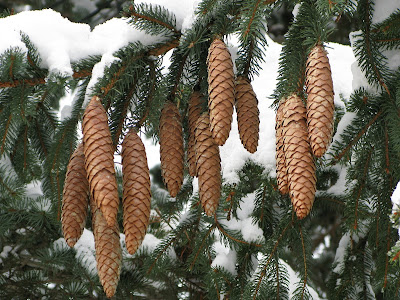 |
| Larix kaempferi - Japanese Larch |
Larix kaempferi commonly known as Japanese Larch is native
to Japan. This species of larch is easily distinguished from the European Larch
by its blue-green foliage in summer and the reddish appearance of its bare
branches in winter.
It is a medium-sized to large deciduous coniferous tree. It
is grows 20–40 m (66 – 132 ft) in height, with a trunk up to 1 m (3.3 ft)
diameter. The crown is broad conic; both the main branches and the side
branches are level, the side branches only rarely drooping.
The young terminal growth shoots are pendulous and long,
russet colored, and by their second year are red with waxy bloom, shallowly
furrowed, and roughened by needle bases of the previous year. The winter buds
at their tips are reddish-brown and resinous; the buds at the sides are
smaller. The pointed needles, 2.5-3.5 cm (1-1.5 in) long are scattered around
the young shoots (‘juvenile’ foliage), but on the older twigs are in rosette of
twenty to thirty, all springing from a short spur shoot. They are soft and blue-green,
slightly wider than those of European Larch, with two stomatal bands beneath,
and they fade to a rich orange color before they fall in autumn.
The flowers of both sexes are found on the same tree, and
they are smaller than those of European Larch. They appear a little in advance
of the needles. The small round brown males are set on the underside of the
branches, and are pale yellow when ripe. The female conelets are erect and
cream or greenish, with reflexed bracts. They later harden, and become brown
squat and broad cones, with scales which are reflexed at their edges. The cones
stand are erect, are rounded in outline, and are 2.5-3.5 cm (1-1.5 in) long.
They ripen by October, and their scales open though the cones persist on the
tree for an indefinite time.
The bark of young trees is at first smooth and reddish,
becoming thick, brown and scaly or finely fissured with age. The branches are
irregular, mostly horizontal and often the leader has a corkscrew formation is
reddish-brown. It is coarse in texture and resinous but strong, hard and
naturally durable, providing a multi-purpose timber, particularly used for
fencing, gates, and estate repair work.
Foresters appreciate this tree as a fast starter, though
not, overall, a producer of very high volume. It is practically free of canker,
and is useful for suppressing ground vegetation, though it will not withstand
shade itself.


























































